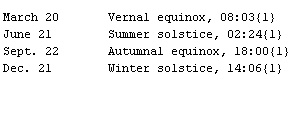- astronomy Table 1
-
▪ TableEarth Perihelion and Aphelion, 1996Jan. 4 Perihelion, 147,088,000 km (91,396,000 mi) from the SunJuly 5 Aphelion, 152,099,000 km (94,510,000 mi) from the Sun
 Equinoxes and Solstices, 1996March 20 Vernal equinox, 08:03{1}June 21 Summer solstice, 02:24{1}Sept. 22 Autumnal equinox, 18:00{1}Dec. 21 Winter solstice, 14:06{1}
Equinoxes and Solstices, 1996March 20 Vernal equinox, 08:03{1}June 21 Summer solstice, 02:24{1}Sept. 22 Autumnal equinox, 18:00{1}Dec. 21 Winter solstice, 14:06{1} Eclipses, 1996April 3-4 Moon, total (begins 21:16{1}), the beginning visible inextreme eastern North America, South America east of theAndes, southern and eastern Greenland, Europe, westernand central Asia, Africa, the Indian Ocean, and extremewestern Australia; the end visible throughout the WesternHemisphere except for the western United States and westernCanada and in Europe, western Asia, and Africa.April 17-18 Sun, partial (begins 22:05{1}), the beginning visible inthe South Pacific Ocean south of Tasmania, Australia; theend visible in the South Pacific west of South America(south of the Galapagos Islands).Sept. 27 Moon, total (begins 03:06{1}), the beginning visible incentral and eastern regions of Canada and the UnitedStates, much of Mexico, South America, Greenland, Europe,western Asia, and Africa; the end visible in the entireWestern Hemisphere, western and central Europe, andwestern Africa.Oct. 12 Sun, partial (begins 13:24{1}), the beginning visiblesouth of Hudson Bay (near Winnipeg) and in northernGreenland; the end visible in northeastern Africa(near Khartoum).{1}Universal time.Adapted from
Eclipses, 1996April 3-4 Moon, total (begins 21:16{1}), the beginning visible inextreme eastern North America, South America east of theAndes, southern and eastern Greenland, Europe, westernand central Asia, Africa, the Indian Ocean, and extremewestern Australia; the end visible throughout the WesternHemisphere except for the western United States and westernCanada and in Europe, western Asia, and Africa.April 17-18 Sun, partial (begins 22:05{1}), the beginning visible inthe South Pacific Ocean south of Tasmania, Australia; theend visible in the South Pacific west of South America(south of the Galapagos Islands).Sept. 27 Moon, total (begins 03:06{1}), the beginning visible incentral and eastern regions of Canada and the UnitedStates, much of Mexico, South America, Greenland, Europe,western Asia, and Africa; the end visible in the entireWestern Hemisphere, western and central Europe, andwestern Africa.Oct. 12 Sun, partial (begins 13:24{1}), the beginning visiblesouth of Hudson Bay (near Winnipeg) and in northernGreenland; the end visible in northeastern Africa(near Khartoum).{1}Universal time.Adapted from The Astronomical Almanac for the Year 1996,Copyright © Science and Engineering Research Council 1995,reproduced by permission of the Controller of HMSO.
The Astronomical Almanac for the Year 1996,Copyright © Science and Engineering Research Council 1995,reproduced by permission of the Controller of HMSO.
* * *
Universalium. 2010.
